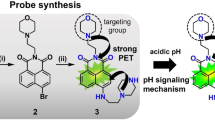Abstract
We have synthesized and applied a nanoparticle-based pH sensor for noninvasive monitoring of intracellular pH changes induced by drug stimulation. The pH sensor is a two-fluorophore-doped nanoparticle sensor (2DFNS) that contains a pH-sensitive indicator (fluorescein isothiocyanate, FITC) and a reference dye (tris(2,2′-bipyridyl)dichlororuthenium(II) hexahydrate, RuBPY). The nanoparticles have an average diameter of 42 ± 3 nm and can easily be taken up by cells for noninvasive intracellular pH measurement. The 2DFNS exhibited excellent pH sensitivity, reversibility, and a dynamic range of pH 4–7 for biological studies. We have used 2DFNS to monitor pH changes in living cells by drug stimulation. Both lysosomal pH changes in murine macrophages stimulated by chloroquine and intracellular acidification in apoptotic cancer cells were monitored in real time and with high pH sensitivity. Hela cells underwent intracellular acidification with a drop in pH from 7.2 to 6.5 after 8 h of treatment with 2 μmol/L dexamethasone, and this intracellular pH drop in the apoptotic cells was not influenced by the addition of zinc ions. The application of 2DFNS to intracellular pH measurements yields some important advantages: excellent pH sensitivity, little environmental effect on the pH dye, excellent quantification, high stability and excellent reversibility.

Scanning images of macrophages loaded with 2DFNS at different times after exposure to 200 μmol/L chloroquine. Images a and b represent fluorescence images of FITC and RuBPY in 2DFNS internalized by a macrophage, respectively. Images labeled c are bright-field images of the macrophage, and those labeled d show a and b merged








Similar content being viewed by others
References
Barry MA, Reynolds JE, Eastman A (1993) Cancer Res 53:2349–2357
Li J, Eastman A (1995) J Biol Chem 270:3203–3211
Caceres-Cortes J, Rajotte D, Dumouchel J, Maddad P, Hoang T (1994) J Biol Chem 269:12084–12091
Gottlieb RA, Giesing H, Zhu J, Engler RL, Babior BM (1995) Proc Natl Acad Sci USA 92:5965–5968
Gottlieb RA, Nordberg J, Skowronski E, Babior BM (1995) Proc Natl Acad Sci USA 93:654–658
Tan W, Shi Z, Smith S, Birnbaum D, Kopelman R (1992) Science 258:778
Zen JM, Patonay G (1991) Anal Chem 63:2934–2938
Chan CM, Fung CS, Wong KY, Lo W (1998) Analyst 123:1843–1847
Price JM, Xu W, Demas JN, DeGraff BA (1998) Anal Chem 70:265–270
Malins C, Glever HG, Keyes TE, Vos JG, Dressick WJ, MacCraith BD (2000) Sens Actuators B 67:89–95
Clarke Y, Xu W, Demas JN, DeGraff BA (2000) Anal Chem 72:3468–3475
Graber ML, DiLillo DC, Friedman BL, Pastoriza-Munoz E (1986) Anal Biochem 156:202–212
Shalom S, Strinkovski A, Peleg G, Druckmann S, Krauss A, Lewis A, Linial M, Ottolenghi M (1997) Anal Biochem 244:256–259
Xin Q, Wightman RM (1998) Anal Chem 70:1677–1681
Rosenzweig Z, Kopelman R (1995) Anal Chem 67:2650–2654
Hanson GT, McAnaney TB, Park ES, Rendell MEP, Yarbrough DK, Chu S, Xi L, Boxer SG, Montrose MH, Remington SJ (2002) Biochemistry 41:15477–15488
Sasaki K, Shi Z, Kopelman R, Masuhara H (1996) Chem Lett 8:141–142
Clark HA, Hoyer M, Philbert MA, Kopelman R (1999) Anal Chem 71:4831–4836
Clark HA, Kopelman R, Tjalkens R, Philbert MA (1999) Anal Chem 71:4837–4843
Ji J, Rosenzweig N, Griffin C, Rosenzweig Z (2000) Anal Chem 72:3497–3503
McNamara KP, Nguyen T, Dumitrascu G, Ji J, Rosenzweig N, Rosenzweig Z (2001) Anal Chem 73:3240–3246
Nalwa HS (ed) (2004) Encyclopedia of nanoscience and nanotechnology. American Scientific, Los Angeles, CA
He X, Wang K, Tan W, Chen J, Duan J, Yuan Y, Lin X (2005) Chin Sci Bulletin 50:2185–2190
Santra S, Zhang PS, Wang K, Tapec R, Tan W (2001) Anal Chem 73:4988–4993
He X, Duan J, Wang K, Tan W, Lin X, He C (2004) J NanoSci Nanotechnol 4:585–589
Wang L, Yang C, Tan W (2005) Nano Lett 51:37–43
Thomas JA, Buchsbaum RN, Zimniak A, Racker E (1979) Biochemistry 18:2210–2218
Engeland MV, Nieland LJW, Ramaekers FCS, Schutte B, Reutelingsperger CPM (1998) Cytometry 31:1–9
Lukas GL, Rotstein OD, Grinstein SJ (1991) Biol Chem 266:24540–24548
Bassoe CF, Laerum OD, Glett J, Hopen G, Haneberg B, Solberg CO (1983) Cytometry 4:254–262
Schmid I, Uittenbogaart CH, Keld B, Giorgi JV, Immunol J (1994) Methods 170:145–157
Barry BA, Eastman A (1993) Arch Biochem Biophys 300:440–450
Brown DG, Sun XM, Cohen GM (1993) J Biol Chem 268:3037–3039
Giannakis C, Forbes IJ, Zalewski PD (1991) Biochem Biophys Res Commun 181:915–920
Acknowledgements
This work was partially supported by the National Key Basic Research Program (2002CB513100-10), Key Project Foundation of China Education Ministry (107084), Key Project of International Technologies Collaboration Program of China (2003DF000039), Program for New Century Excellent Talents in University (NCET), National Science Foundation of P.R.China (90606003, 20405005) and Outstanding Youth Foundation of Hunan Province (06JJ10004).
Author information
Authors and Affiliations
Corresponding author
Rights and permissions
About this article
Cite this article
Peng, J., He, X., Wang, K. et al. Noninvasive monitoring of intracellular pH change induced by drug stimulation using silica nanoparticle sensors. Anal Bioanal Chem 388, 645–654 (2007). https://doi.org/10.1007/s00216-007-1244-9
Received:
Revised:
Accepted:
Published:
Issue Date:
DOI: https://doi.org/10.1007/s00216-007-1244-9




